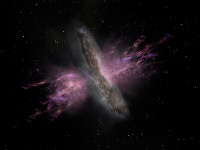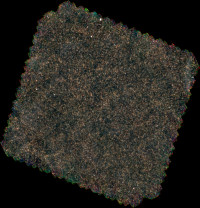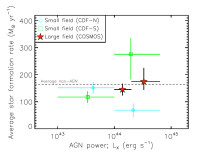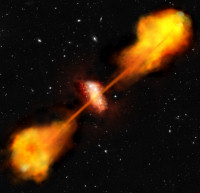Black holes and star formation: a Herschel perspective
13 February 2013
The effects of supermassive black holes on their host galaxies pose a tricky puzzle: are black holes able to influence, and possibly even suppress, star-formation activity on galactic scales? Astronomers have been searching for a signature of such a feedback effect, and have been spurred on recently by the large surveys of distant galaxies compiled with ESA's Herschel Space Observatory. A variety of results has emerged from the first joint analyses of these data and other observations, performed either in X-rays or in radio waves, but the only certainty so far is that it remains a vexed question.
 |
|
Artist's impression of galaxy with outflow. |
Surveys of the distant cosmos reveal that in the early days of the Universe a substantial fraction of galaxies were quite different from those that we observe at present. In particular, their star formation activity was extremely fierce, as these galaxies were producing hundreds or even thousands of stars every year – a very intense pace, compared to the one or two stars produced each year in typical galaxies in the local Universe.
These prolific and distant stellar factories contain large amounts of interstellar gas and dust from which stars are produced. Heated by starlight, interstellar dust shines brightly at the far-infrared and sub-millimetre wavelengths probed by Herschel, making it an extraordinary tool to study the star formation activity of galaxies in the early Universe.
"Herschel is revealing more and more about the history of star formation in the life of the Universe," comments Göran Pilbratt, Herschel Project Scientist at ESA. "These data are helping astronomers to investigate the dramatic drop in star formation rate between early and present-day galaxies."
Numerical simulations suggest that star formation in early galaxies might be suppressed by the activity of the supermassive black holes at their centres. In some galaxies, the central black hole accretes matter at extraordinarily high rates, giving rise to very bright emission across the electromagnetic spectrum; these galaxies are said to host an active galactic nucleus (AGN). The accretion process is accompanied by the outflow of material and, if it is powerful enough, this may eventually drain the galaxy's reservoir of gas, halting its star-forming activity.
Since active galactic nuclei are only observed in a small fraction of galaxies, astronomers believe that they correspond to a relatively short-lived phase in a galaxy's life. However, surveys of the distant cosmos reveal that galaxies hosting an AGN were more common at early times than at present, and that galaxies hosting the most powerful AGN are usually found in the early Universe. For this reason, astronomers have long been searching for a signature of AGN-induced feedback on star formation by observing distant galaxies at several different wavelengths.
 |
|
Herschel's view of star-forming galaxies in the COSMOS field. Credit: ESA/Herschel/SPIRE/ HerMES Key Programme |
The advent of Herschel has sparked a number of new studies in this field. Several teams of astronomers are combining Herschel's large surveys of star-forming galaxies with observations performed at other wavelengths to trace the AGN activity. The key question for all of them: is the activity of supermassive black holes correlated to star formation in their host galaxies and, if so, to what degree?
One of the earliest results to emerge showed evidence for powerful AGN having halted their host galaxy's star formation. In this study, led by Mathew Page from the Mullard Space Science Laboratory, UK, the astronomers combined data from Herschel and NASA's Chandra X-ray Observatory to study the relation between star formation rate and AGN power – the latter estimated by means of the X-ray data.
"Our study shows a double trend: for moderately powerful AGN, the star formation rate of their host galaxies increases with the AGN power. However, this seems to no longer hold for the most powerful AGN in our sample, which appear to be hosted in galaxies with a somehow reduced star-forming activity," says Page.
This surprising result was based on observations of several dozens of galaxies in one field of the sky. Would this result hold for larger samples of galaxies and for different regions of the sky? A recent study, led by Christopher Harrison, a PhD student at the University of Durham, UK, and based on observations of three different fields in the sky from Herschel and Chandra, shows that it doesn't.
"We looked at several hundreds of AGN-hosting galaxies which are bright in X-rays, and stacked them to measure how the average star formation rate varies as a function of the AGN power," explains Harrison, "but we found different results while analysing different patches of the sky."
When they looked at the same field studied by Page and collaborators, Harrison and his colleagues also found that the most powerful AGN have lower star formation rates; however, the same result did not emerge from the analysis of the other fields they observed, which include a much larger field containing over ten times more AGN.
 |
|
Star formation rate and active galactic nuclei power. Credit: Image courtesy of Christopher Harrison, University of Durham, UK |
"Our study shows that the average star formation rate of galaxies that host very powerful AGN is not different from that of galaxies hosting less powerful AGN. In fact, the star formation rates that we measure are even consistent with those of comparable galaxies that do not display any ongoing AGN activity," says Harrison. "This indicates that no clear signature of AGN suppressing star formation in their host galaxies can be extracted from the data with this type of analysis," he adds.
Whilst both studies of X-ray selected AGN are based on average estimates of the star formation rate and AGN power – computed by stacking several galaxies together – Page and his colleagues also looked at the sources individually.
"By looking at the individual sources, we verified that the most powerful AGN in our sample are indeed not detected in the Herschel data," says Page. "This suggests that the star formation activity of their host galaxies is weak."
Why such an effect would appear only on certain patches of the sky and not others is currently being debated. One of the possible explanations is that AGN activity did contribute to suppress star formation in galaxies but that it does not show up in most of the data because it was a short-lived phenomenon.
"If the suppression of star formation took place via a very brief but effective AGN phase, it would be extremely difficult to find a signature of such an effect in a large survey of galaxies, because it may be washed out when looking at average properties," says Harrison.
"To find out more, we need to better understand the properties of individual objects in the surveys," says David Alexander, one of Harrison's supervisors at the University of Durham, UK, "So we plan to study samples of AGN and their host galaxies and to analyse their emission at several different wavelengths."
Another recent study, led by Peter Barthel of the University of Groningen, The Netherlands, is following a similar approach, as the astronomers have been using Herschel to investigate star formation in individual galaxies that host very powerful AGN. They chose radio data rather than X-rays for their sample, to concentrate on the most powerful AGN.
 |
|
Artist's impression of galaxy with radio-bright jets and lobes. |
"By choosing the AGN on the basis of their radio emission, we can single out some truly extreme sources that are more powerful than those detected in X-ray surveys. The radio emission is generated outside of the AGN's host galaxy – in the relativistic jets and in the gigantic radio lobes. As such, it is a reliable indicator of the AGN power as opposed to X-ray emission, which is prone to absorption by intergalactic material," explains Barthel.
"In this study, we looked at three of the most exceptional AGN known, which lie in very massive galaxies that host supermassive black holes accreting mass at dramatically high rates. The Herschel data revealed highly prolific star formation activity in the host galaxies, as the galaxies appear to produce five hundred to a thousand stars per year," he adds.
The positive correlation between star formation rate and AGN power found by Barthel and his colleagues suggests that these mighty black holes have not quenched the star formation in their host galaxies.
"We are now extending this study to several dozen powerful, radio-bright AGN," says Barthel, "and a preliminary analysis shows that the majority of them are indeed hosted in galaxies that are forming stars very vigorously."
The next step for the various teams of astronomers involved in these investigations is to observe large numbers of individual sources in greater detail, possibly trying to bridge the gap between the exceptionally massive galaxies hosting very powerful AGN selected using radio data and the less extreme ones selected in X-rays.
"Herschel has triggered a great number of studies that are addressing the intricacies of AGN feedback on star formation from several different angles. We are very curious to see what the data eventually will tell us," concludes Pilbratt.
Notes for editors
Two of the studies presented here (Page et al., 2012, and Harrison et al., 2012) are based on data acquired with the SPIRE instrument on board ESA's Herschel Space Observatory as part of the Herschel Multi-tiered Extragalactic Survey (HerMES), which were combined with data from NASA's Chandra X-ray Observatory. HerMES is a Guaranteed Time Key Programme designed to probe galaxy evolution at high redshift. The project is carried out by a large international collaboration led by Seb Oliver (University of Sussex, UK) and Jamie Bock (Caltech, USA). The study by Harrison et al. (2012) is also based on data from the The Great Observatories Origins Deep Survey: far infrared imaging with Herschel (GOODS-Herschel), a Herschel Open Time Key Programme carried out by a large international collaboration led by David Elbaz (CEA, France).
The study by Barthel et al. (2012) is based on data from both the PACS and SPIRE instruments on board Herschel. The data were acquired as part of the Guaranteed Time Programme "The Herschel Legacy of distant radio-loud AGN" which is led by Peter Barthel (University of Groningen, The Netherlands). In this study, mid-infrared, radio and X-ray data from the literature were also used.
Herschel is an ESA space observatory with science instruments provided by European-led Principal Investigator consortia and with important participation from NASA.
The PACS instrument contains an imaging photometer (camera) and an imaging spectrometer. The camera operates in three bands centred on 70, 100, and 160 μm, respectively, and the spectrometer covers the wavelength range between 51 and 220 μm. PACS has been developed by a consortium of institutes led by MPE (Germany) and including UVIE (Austria); KU Leuven, CSL, IMEC (Belgium); CEA, LAM (France); MPIA (Germany); INAF-IFSI/OAA/OAP/OAT, LENS, SISSA (Italy); IAC (Spain). This development has been supported by the funding agencies BMVIT (Austria), ESA-PRODEX (Belgium), CEA/CNES (France), DLR (Germany), ASI/INAF (Italy), and CICYT/MCYT (Spain).
The SPIRE instrument contains an imaging photometer (camera) and an imaging spectrometer. The camera operates in three wavelength bands centred on 250, 350 and 500 µm, and so can make images of the sky simultaneously in three sub-millimetre colours; the spectrometer covers the wavelength range between 194 and 671 μm. SPIRE has been developed by a consortium of institutes led by Cardiff Univ. (UK) and including Univ. Lethbridge (Canada); NAOC (China); CEA, LAM (France); IFSI, Univ. Padua (Italy); IAC (Spain); Stockholm Observatory (Sweden); Imperial College London, RAL, UCL-MSSL, UKATC, Univ. Sussex (UK); Caltech, JPL, NHSC, Univ. Colorado (USA). This development has been supported by national funding agencies: CSA (Canada); NAOC (China); CEA, CNES, CNRS (France); ASI (Italy); MCINN (Spain); SNSB (Sweden); STFC (UK); and NASA (USA).
Related publications
C. Harrison, et al., "No Clear Submillimeter Signature Of Suppressed Star Formation Among X-Ray Luminous Active Galactic Nuclei", 2012, ApJ, 760, L15. DOI: 10.1088/2041-8205/760/1/L15
P. Barthel, et al., "Extreme Host Galaxy Growth In Powerful Early-Epoch Radio Galaxies", 2012, ApJ, 757, L26. DOI: 10.1088/2041-8205/757/2/L26
M. Page, et al., "The suppression of star formation by powerful active galactic nuclei", 2012, Nature, 485, 213. DOI: 10.1038/nature11096
Contacts
Mathew Page
Mullard Space Science Laboratory
University College London, UK
Email: mjp![]() mssl.ucl.ac.uk
mssl.ucl.ac.uk
Phone: +44-1483-204283
Christopher Harrison
University of Durham, UK
Email: c.m.harrison![]() durham.ac.uk
durham.ac.uk
Phone: +44-191-334-3684
David Alexander
University of Durham, UK
Email: d.m.alexander![]() durham.ac.uk
durham.ac.uk
Phone: +44-191-334-3594
Peter Barthel
Kapteyn Astronomical Institute
University of Groningen, The Netherlands
Email: p.d.barthel![]() rug.nl
rug.nl
Phone: +31-50-363-4064
Göran Pilbratt
ESA Herschel Project Scientist
Research and Scientific Support Department
Directorate of Science and Robotic Exploration
ESA, The Netherlands
Email: gpilbratt![]() rssd.esa.int
rssd.esa.int
Phone: +31-71-565-3621

